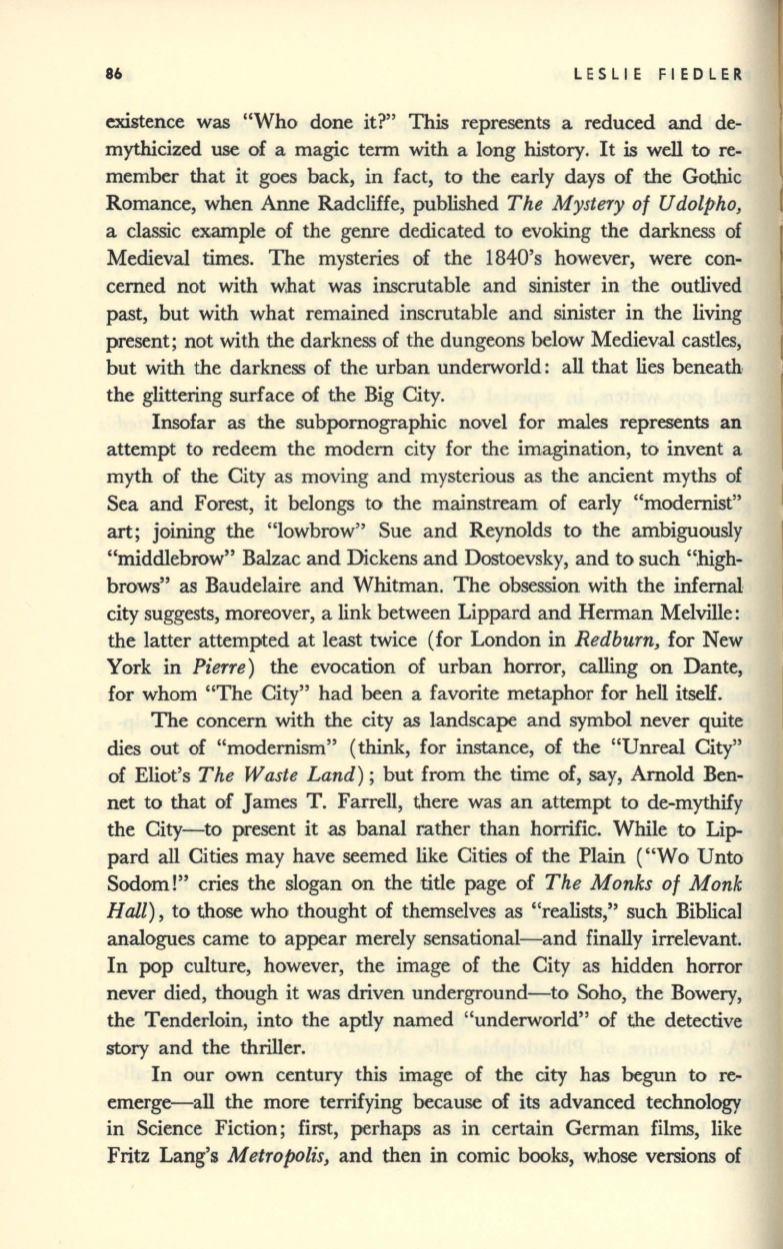
86
LESLIE FIEDLER
existence was "Who done it?" This represents a reduced and de–
mythicized use of a magic term with a long history. It is well to re–
member that it goes back, in fact, to the early days of the Gothic
Romance, when Anne Radcliffe, published
The Mystery of Udolpho,
a classic example of the genre dedicated to evoking the darkness of
Medieval times. The mysteries of the 1840's however, were con–
cerned not with what was inscrutable and sinister in the outlived
past, but with what remained inscrutable and sinister in the living
present; not with the darkness of the dungeons below Medieval castles,
but with the darkness of the urban underworld: all that lies beneath
the glittering surface of the Big City.
Insofar as the subpornographic novel for males represents an
attempt to redeem the modem city for the imagination, to invent a
myth of the City as moving and mysterious as the ancient myths of
Sea and Forest, it belongs to the mainstream of early "modernist"
art;
joining the "lowbrow" Sue and Reynolds to the ambiguously
"middlebrow" Balzac and Dickens and Dostoevsky, and to such "high–
brows" as Baudelaire and Whitman. The obsession with the infernal·
city suggests, moreover, a link between Lippard and Herman Melville:
the latter attempted at least twice (for London in
Redburn,
for New
York in
Pierre)
the evocation of urban horror, calling on Dante,
for whom "The City" had been a favorite metaphor for hell itself.
The concern with the city as landscape and symbol never quite
dies out of "modernism" (think, for instance, of the "Unreal City"
of Eliot's
The Waste Land);
but from the time of, say, Arnold Ben–
net to that of James T. Farrell, there was an attempt to de-mythify
the City-to present it as banal rather than horrific. While to Lip–
pard all Cities may have seemed like Cities of the Plain ("Wo Unto
Sodom!" cries the slogan on the title page of
The Monks of Monk
Hall),
to those who thought of themselves as "realists," such Biblical
analogues came to appear merely sensational- and finally irrelevant.
In pop culture, however, the image of the City as hidden horror
never died, though it was driven underground-to Soho, the Bowery,
the Tenderloin, into the aptly named "underworld" of the detective
story and the thriller.
In our own century this image of the city has
begun
to re–
emerge-all the more terrifying because of its advanced technology
in Science Fiction; first, perhaps as in certain German films, like
Fritz Lang's
Metropolis,
and then
in
comic
books,
whose versions of


